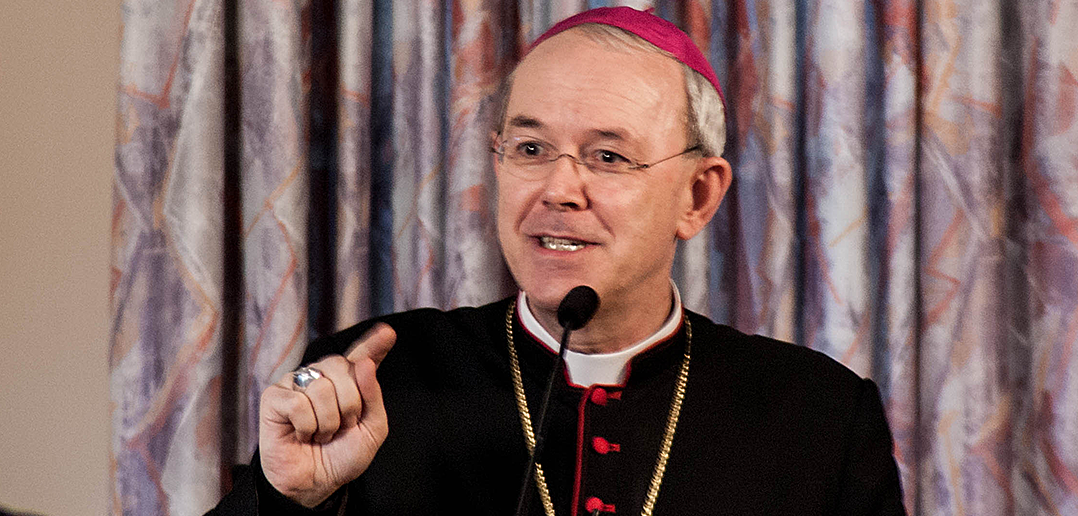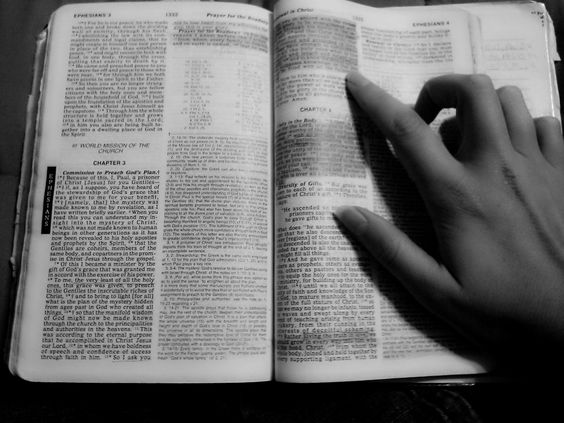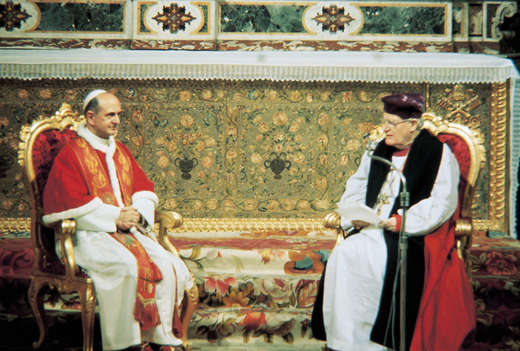
And why speak I of the world to come? Since here this mystery makes earth become to you a heaven. Open only for once the gates of heaven and look in; nay, rather not of heaven, but of the heaven of heavens; and then you will behold what I have been speaking of. For what is there most precious of all, this will I show you lying upon the earth. For as in royal palaces, what is most glorious of all is not walls, nor golden roofs, but the person of the king sitting on the throne; so likewise in heaven the Body of the King. But this, you are now permitted to see upon earth. For it is not angels, nor archangels, nor heavens and heavens of heavens, that I show you, but the very Lord and Owner of these.
– St. John Chrysostom, Homily on 1st Cor., as cited in Dominus Est, by Bishop Athanasius Schneider, p. 34
On February 14, 2015, Bishop Athanasius Schneider of Astana, Kazakhstan, was sponsored by the Paulus Institute to give a talk in Washington, DC. During the talk, he proposed concrete actions — ten essential elements — which should be implemented to accomplish liturgical renewal.
As an attendee, I was impressed once again by his excellency’s concern for reverence and piety in Catholic worship. Because of the deep value of the insights he presented, I would like to offer to you my own summary of his principle themes.
The bishop instructed that ever since apostolic times, the Church sought to have holy liturgy, and that it is only through the action of the Holy Spirit that one can truly adore Christ. Exterior gestures of adoration that express interior reverence are vital within the context of the liturgy. These include bowing, genuflections, prostrations, and the like. His excellency cited St. John Chrysostom’s writings on liturgy, particularly focusing on the following theme: The liturgy of the Church is a participation in and must be modeled upon the heavenly liturgy of the angels.
The notion of heavenly liturgy, and our participation in it at the Holy Sacrifice of the Mass, offers some perspective to those of us who may be tempted to take for granted the incredible miracle in our midst. The reality is that each Catholic church is, itself, a place wherein dwell angels, archangels, the kingdom of God, and God’s own Heavenly Self. If we were somehow able to be transported to the heavenly liturgy, we would not dare speak even to those we know and love. When we are within a Church, we should therefore speak reservedly, and then only of sacred things.
In the early church, the altar and other sacred items were veiled out of respect for the sacred mystery in which they played a role. There was not, contrary to popular belief in our present time, a versus populum celebration of Mass or even a widespread practice of communion in the hand. The priest and the people faced together towards God in the liturgical East.
When we celebrate liturgy, it is God who must be at the center. The incarnate God. Christ. Nobody else. Not even the priest who acts in His place.
It impoverishes the liturgy when we reduce the signs and gestures of adoration. Any liturgical renewal must therefore restore these and bring about a more Christocentric and transcendent character of the earthly liturgy which is more reminiscent of the angelic liturgy.
Ten Elements of Renewal
Bishop Schneider offered these 10 points of implementation which he views as fundamental for liturgical renewal (audio begins at 27 minutes):
1. The tabernacle, where Jesus Christ, the Incarnate God, is really present under the species of bread should be placed in the center of the sanctuary, because in no other sign on this earth is God, the Emmanuel, so really present and so near to man as in the tabernacle. The tabernacle is the sign indicating and containing the Real Presence of Christ and should therefore be closer to the altar and constitute with the altar the one central sign indicating the Eucharistic mystery. The Sacrament of the Tabernacle and the Sacrifice of the Altar should therefore not be opposed or separated, but both in the central place and close together in the sanctuary. All the attention of those who enter a church should spontaneously be directed towards the tabernacle and the altar.
2. During the Eucharistic liturgy – at the very least during the Eucharistic prayer – when Christ the Lamb of God is immolated, the face of the priest should not be seen by the faithful. Even the Seraphim cover their faces (Isaiah 6:2) when adoring God. Instead, the face of the priest should be turned toward the cross, the icon of the crucified God.
3. During the liturgy, there should be more signs of adoration — specifically genuflections — especially each time the priest touches the consecrated host.
4. The faithful approaching to receive the Lamb of God in Holy Communion should greet and receive Him with an act of adoration, kneeling. Which moment in the life of the faithful is more sacred than this moment of encounter with the Lord?
5. There should be more room for silence during the liturgy, especially during those moments which most fully express the mystery of the redemption. Especially when the sacrifice of the cross is made present during the Eucharistic prayer.
6. There should be more exterior signs which express the dependence of the priest on Christ, the High Priest, which would more clearly show that the words the priest speaks (ie., “Dominus Vobiscum“) and the blessings he offers to the faithful depend on and flow out from Christ the High Priest, not from him, the private person. Not “I greet you” or “I bless you” but “I the Lord” do these things. Christ. Such signs could be (as was practiced for centuries) the kissing of the altar before greeting the people to indicate that this love flows not from the priest but from the altar; and also before blessing, to kiss the altar, and then bless the people. (This was practiced for millennium, and unfortunately in the new rite has been abolished.) Also, bowing towards the altar cross to indicate that Christ is more important than the priest. Often in the liturgy — in the old rite — when a priest expressed the name of Jesus, he had to turn to the cross and make a bow to show that the attention should be on Christ, not him.
7. There should be more signs which express the unfathomable mystery of the redemption. This could be achieved through the veiling of liturgical objects, because veiling is an act of the liturgy of the angels. Veiling the chalice, veiling the paten with the humeral veil, the veiling of the corporal, veiling the hands of the bishop when he celebrates a solemnity, The use of communion rails, also, to veil the altar. Also signs – signs of the cross by the priest and the faithful. Making signs of the cross during the priest by the Eucharistic prayer and by the faithful during other moments of the liturgy; when we are signing ourselves with the cross it is a sign of blessing. In the ancient liturgy, three times during the Gloria, the Credo, and the Sanctus, the faithful made the sign of the cross. These are expressions of the mystery.
8. There should be a constant sign which expresses the mystery also by means of human language – that is to say, Latin is a sacred language demanded by the Second Vatican Council in celebration of every holy Mass and in each place a part of the Eucharistic prayer should always be said in Latin.
9. All those who exercise an active role in the liturgy, such as lectors, or those announcing the prayer of the faithful, should always be dressed in the liturgical vestments; and only men, no women, because this is an exercise in the sanctuary, close to the priesthood. Even reading the lectionary is directed towards this liturgy which we are celebrating to Christ. And therefore only men dressed in liturgical vestments should be in the sanctuary.
10. The music and the songs during the liturgy should more truly reflect the sacred character and should resemble the song of the angels, like the Sanctus, in order to be really more able to sing with one voice with the angels. Not only the sanctus, but the entire Holy Mass. It would be necessary that the heart, mind and voice of the priest and the faithful be directed towards The Lord. And that this would be manifested by exterior signs and gestures as well.
There is a great deal to reflect on here. Each of these ten points seems, to me at least, indispensable in our pursuit of truly reverent worship in our churches. None of these points is incompatible with either the Church’s ancient liturgy or, perhaps more importantly, with the liturgy envisioned by the Council Fathers in Sacrosanctum Concilium.
It would be a tremendous blessing if more bishops would take up these ten points as essential guidelines for liturgy in their dioceses. I encourage you to send them along to your own bishop for his consideration. There were more treasures in the Q&A, which I have elected not to transcribe due to the length. (If you are interested in the full audio of the talk, see below.)
I also had the opportunity to meet briefly with the bishop at the conclusion of his talk. When I thanked him for his leadership in a time where it seems so many of our shepherds are not speaking with clear voices for the teachings of the Church, he said to me, “It is you who must do this. You, the faithful, your families. You must be holy. You must teach the faith to your children. You must inspire the priests.” On the subject of vocations, he said that we must offer our children to God if we wish for them to receive a call. It would seem that with this advice — paired with the concrete suggestions he previously offered in his article published earlier this year — he is calling on us, the laity, to begin a holiness revolution if we wish to see reform the Church.
It seems we had better get started.


